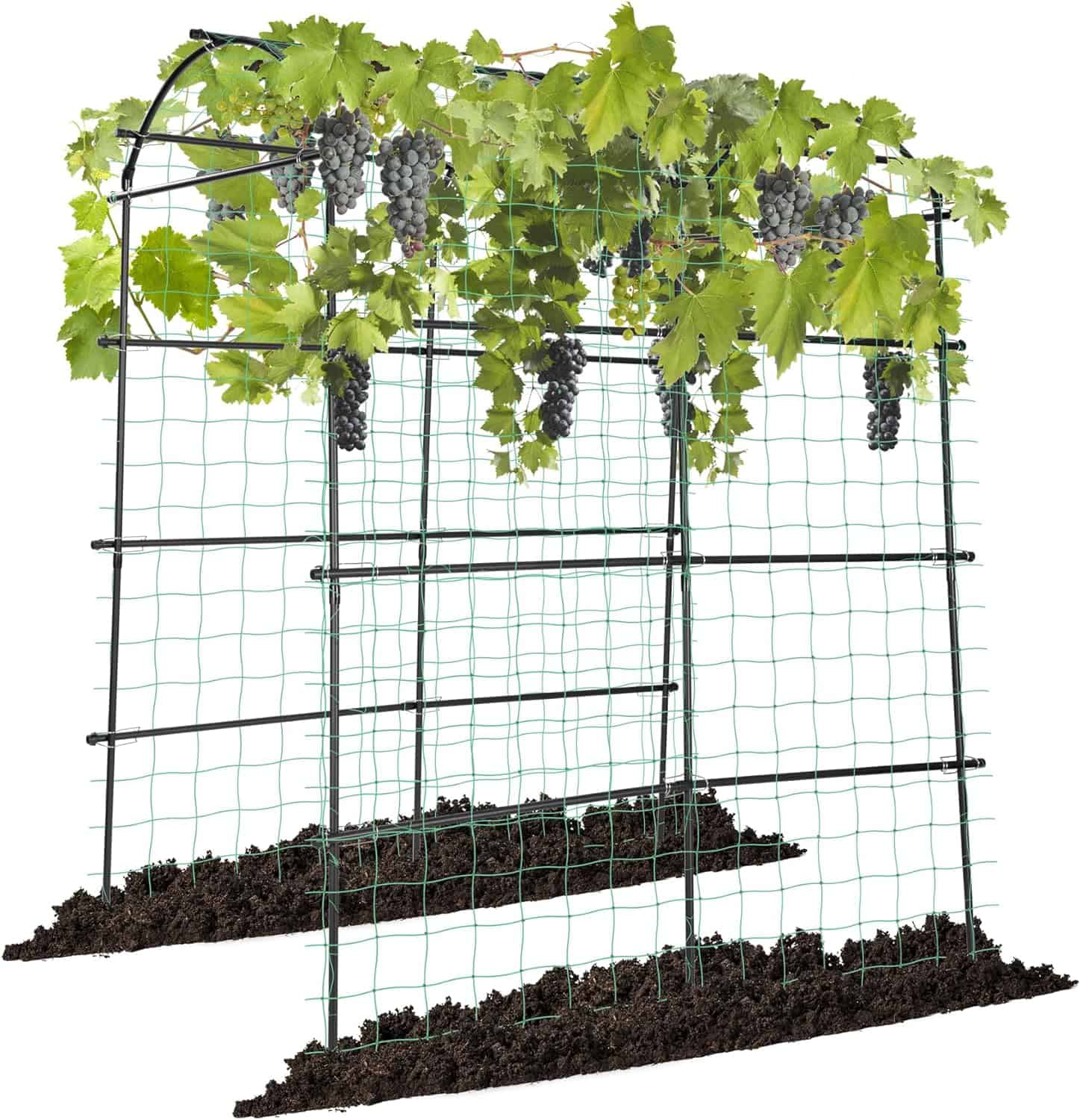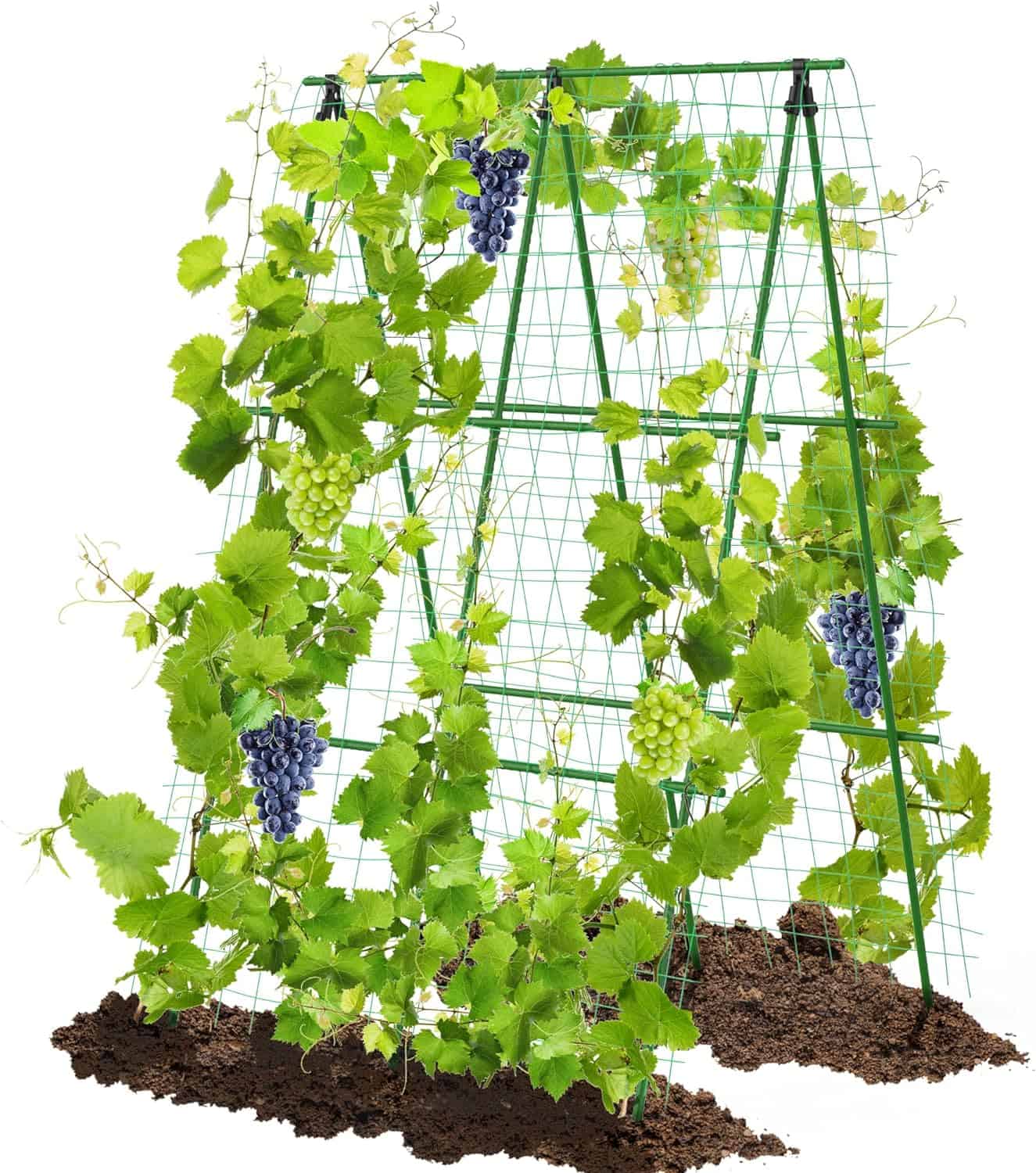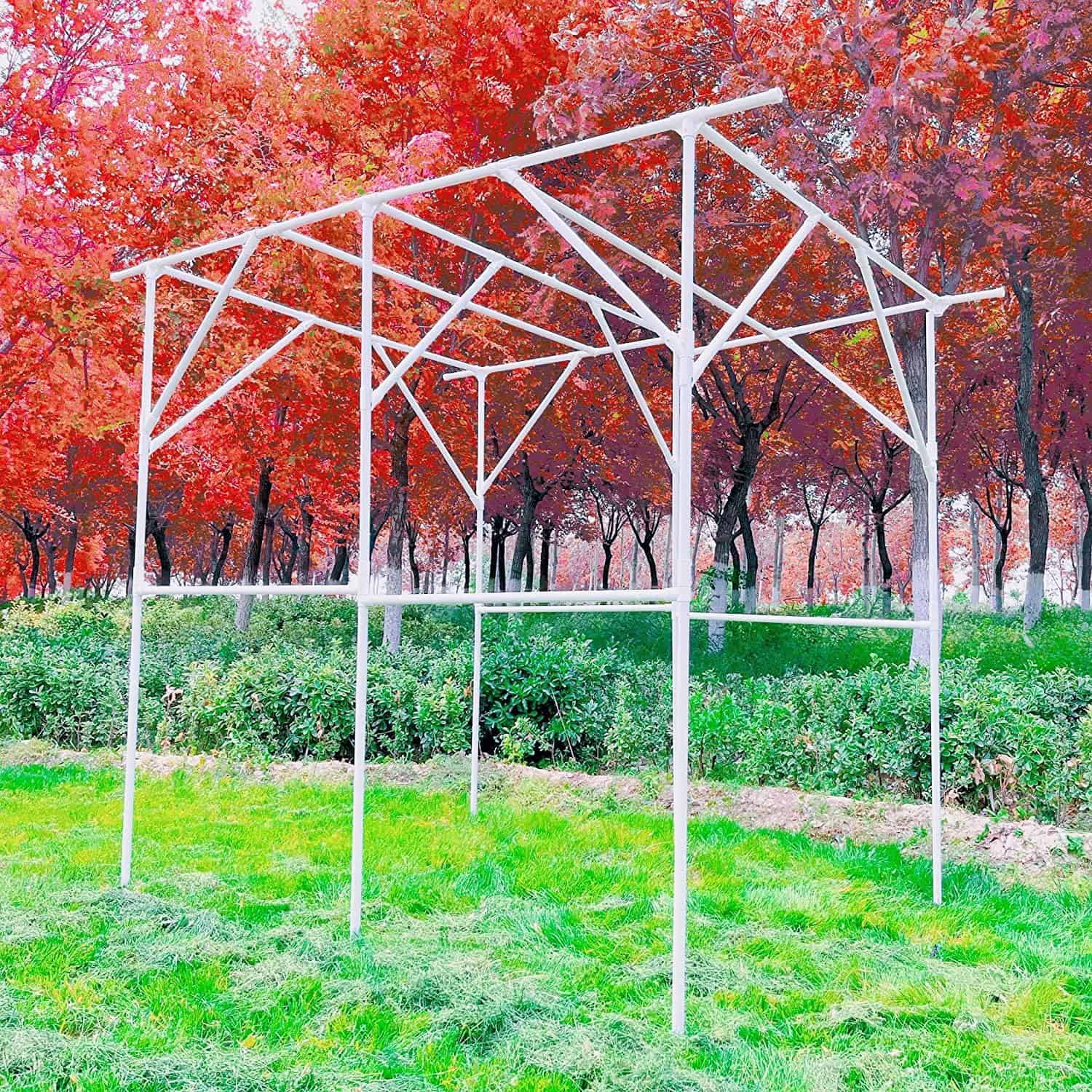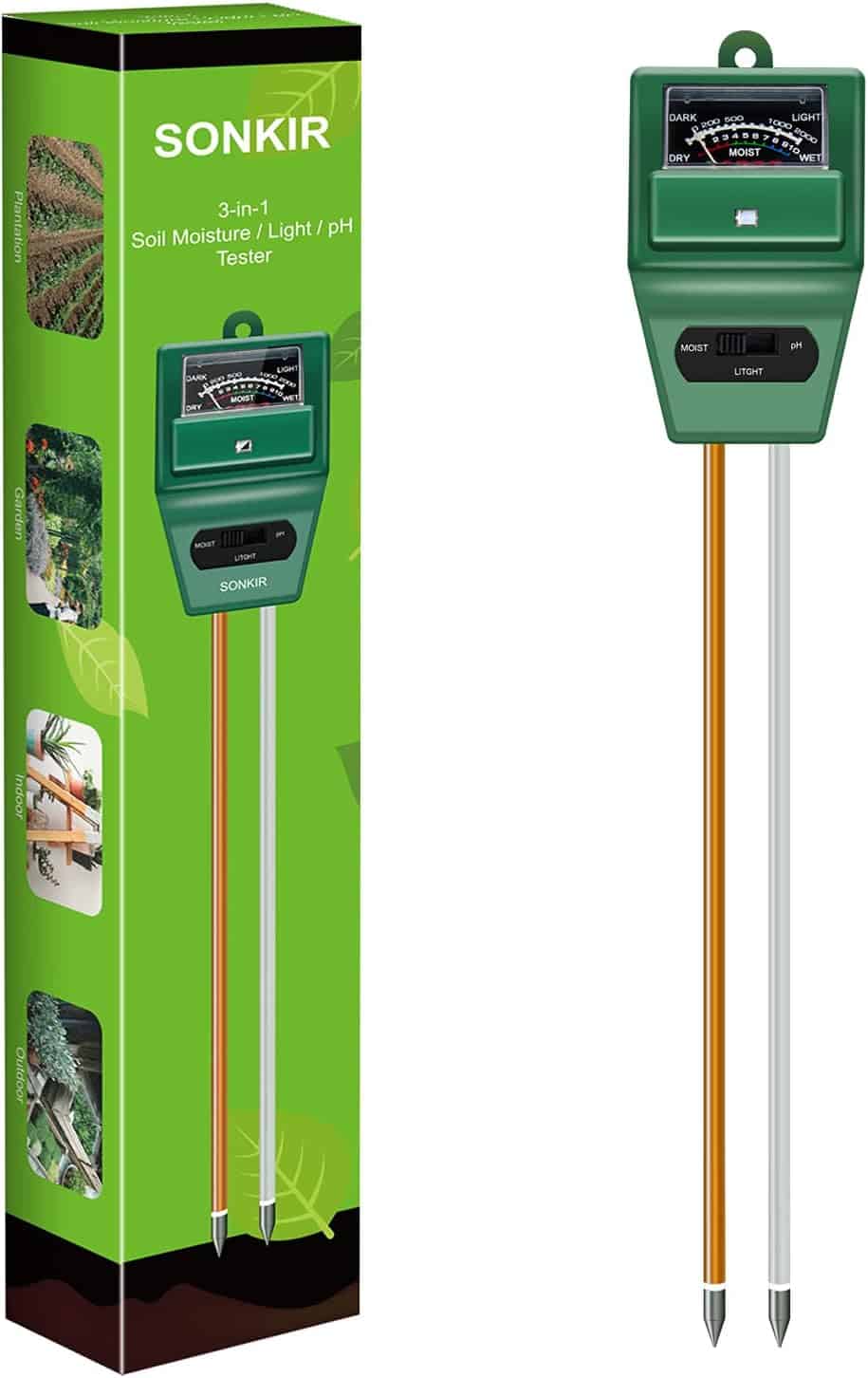Growing grapes on a trellis can be a rewarding and enjoyable experience. Not only does it provide you with fresh grapes to eat or use in recipes, but it also adds a beautiful element to your garden or landscape.
This post may contain affiliate links.
However, it can be a bit intimidating if you’ve never done it before. In this article, we’ll provide you with some tips and tricks to help you successfully grow grapes on a trellis.
Related Article: Growing Grapes on a Fence
First, let’s talk about the trellis itself. A trellis is a structure that supports and trains the grapevines to grow in a specific way. It can be made from various materials such as wood, metal, or PVC pipe.
The trellis should be sturdy enough to support the weight of the grapevines and the grapes themselves. It should also be tall enough to allow the grapevines to grow vertically, as this is the best way for them to receive sunlight and air circulation.
Choosing the Right Trellis for Your Vines
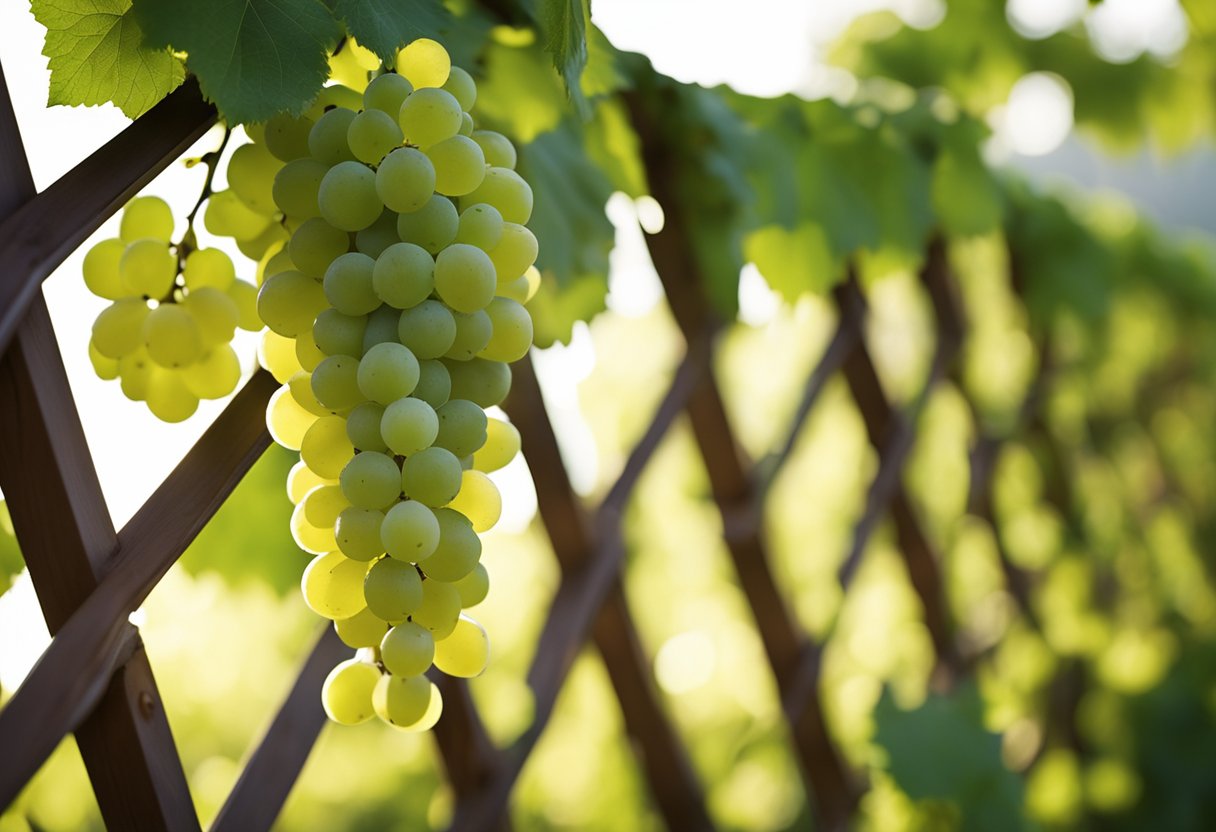
When it comes to growing grapes, a trellis is an essential element that provides support for the vines and helps maximize their growth and yield. Choosing the right trellis for your vines can be a daunting task, but with a little bit of knowledge and planning, you can select the perfect one for your needs.
Trellis Types and Materials
There are several types of trellises, including the standard T-shaped trellis, the pergola, and the arbor. Each type has its own advantages and disadvantages, so it’s important to choose the one that best suits your needs.
The materials used for trellises can vary widely, from wood to metal to PVC. Wood is a popular choice because it’s sturdy and can be easily customized to fit your specific needs.
Metal is also a good option because it’s durable and can withstand harsh weather conditions. PVC is a more affordable option that’s easy to install and maintain.
Related Article: What to Do With Homegrown Grapes
Location and Sunlight Considerations
When choosing a trellis, it’s important to consider the location and amount of sunlight your vines will receive. Grapes need at least six hours of sunlight per day to grow properly, so make sure your trellis is located in an area that receives adequate sunlight.
The location of your trellis should also be chosen carefully to avoid any obstacles that could hinder the growth of your vines. Make sure to choose a location that’s free from trees, buildings, or any other structures that could block the sunlight or prevent proper airflow.
Support Structure Fundamentals
The support structure of your trellis is also an important factor to consider. The trellis should be sturdy enough to support the weight of the vines and any fruit they produce. Make sure to choose a support structure that’s strong enough to withstand strong winds and heavy rain.
The spacing between the wires on your trellis is also important. The wires should be spaced closely enough to provide adequate support for the vines, but not so close that they become tangled or difficult to manage.
Planting and Training Grapevines
Preparing the Soil
Before planting grapevines on a trellis, it’s important to prepare the soil properly. The soil should be well-drained and have a pH level between 6.0 and 6.5. You can test the soil pH level with a soil test kit.
To prepare the soil, remove any weeds or grass from the planting area. Loosen the soil to a depth of at least 12 inches and mix in compost or aged manure to improve soil fertility. If the soil is heavy clay, add sand or perlite to improve drainage.
Soil pH Meter, MS02 3-in-1 Soil Moisture/Light/pH Tester Gardening Tool Kits for Plant Care
Planting Grapevines
When planting grapevines, choose a grape variety that is well-suited to your climate and soil type. Dig a hole that is twice as wide and deep as the root ball of the vine. Place the vine in the hole and backfill with soil, firming the soil around the base of the plant.
Water the vine thoroughly after planting and add a layer of mulch around the base of the plant to help retain moisture and suppress weeds. If planting multiple vines, space them at least 6 feet apart to allow for proper growth and airflow.
Training Young Vines
To train young grapevines on a trellis, select one or two strong shoots to become the main trunk(s) and remove any other shoots. Tie the trunk(s) to the trellis using soft plant ties, being careful not to damage the bark.
As the vine grows, select the strongest shoots to become the fruiting canes and prune away any weaker shoots. Train the fruiting canes along the trellis, tying them in place as needed.
Pruning and Maintenance for Healthy Growth
Annual Pruning Techniques
Pruning is an essential part of maintaining healthy grapevines on a trellis. It involves removing unwanted or dead wood to promote new growth, increase fruit production, and prevent the spread of diseases.
The best time to prune grapevines is during the dormant season, which typically occurs in late winter or early spring.
To prune your grapevines, start by removing any dead, diseased, or damaged wood. Then, cut back the previous year’s growth to two to three buds.
This will encourage the vine to produce new shoots and fruit. Be sure to prune evenly on both sides of the vine to maintain balance and prevent overgrowth.
Related Article: Growing Grapes in Pots: Tips and Tricks for Successful Container Gardening
Grapevine Care Throughout the Seasons
Proper maintenance is crucial for healthy grapevine growth and fruit production. Here are some tips for caring for your grapevines throughout the seasons:
- Spring: After pruning, apply a balanced fertilizer to the soil. This will provide the necessary nutrients for new growth and fruit production. Also, be sure to water your grapevines regularly, especially during dry spells.
- Summer: Monitor your grapevines for signs of disease or insect infestations. If you notice any issues, treat them promptly to prevent further damage. Additionally, thin out excess fruit to promote larger, healthier grapes.
- Fall: As the growing season comes to a close, reduce watering to help the grapevines prepare for winter. Remove any remaining fruit and foliage to prevent the spread of diseases. Also, consider applying a layer of mulch around the base of the vine to protect the roots from freezing temperatures.
- Winter: Once the grapevines have gone dormant, it’s time to prune again. Remove any dead or diseased wood, and cut back the previous year’s growth to two to three buds. This will prepare the vine for new growth in the spring. Additionally, monitor the soil moisture levels and water as needed to prevent dehydration.
The Benefits of Growing Grapes on a Trellis
If you’re looking to grow grapes in your backyard or garden, using a trellis can provide numerous benefits. Here are some advantages of growing grapes on a trellis:
Improved Air Circulation and Health
When grapes are grown on a trellis, they are lifted off the ground and have better air circulation. This reduces the risk of fungal diseases and pests that thrive in damp environments.
The trellis also allows for better sun exposure, which helps grapes to ripen evenly and develop their full flavor.
Easier Harvesting and Grape Production
Trellising makes it easier to harvest grapes and maintain the vineyard. With the grapes lifted off the ground, it’s easier to see and harvest them. The trellis also provides support for the vines, which can lead to higher grape production and better quality fruit.
Aesthetic Advantages for Your Garden
Using a trellis to grow grapes can also be a beautiful addition to your garden or backyard. The trellis can be designed to complement your landscape and provide a visual focal point. You can choose from various trellis materials and designs to match your garden’s style.
Frequently Asked Questions
What are the essential considerations when designing a grape trellis?
When designing a grape trellis, it is important to consider the variety of grape you are growing, the climate of your region, and the available space for the trellis. You should also consider the type of soil and drainage in the area where you plan to install the trellis.
Can you grow grapes on a trellis in containers, and if so, how?
Yes, you can grow grapes on a trellis in containers. To do so, choose a large container with good drainage and fill it with a well-draining potting mix. Plant your grapevine in the container and train it to grow up the trellis just as you would if it were planted in the ground.
What are the advantages of using a T-post trellis for grapevines?
A T-post trellis is a popular choice for grapevines because it is sturdy and easy to install. It also allows for good air circulation around the vines, which can help prevent disease. Additionally, the T-post trellis allows for easy pruning and maintenance of the grapevines.
How do you properly train grapevines to grow on a trellis?
To properly train grapevines to grow on a trellis, begin by selecting the strongest and healthiest shoot to be the main trunk. Tie the trunk to the trellis using a soft material such as twine.
As the vine grows, train the shoots to grow along the trellis, tying them to the trellis as necessary. Prune the vine regularly to remove any unwanted growth.
What is the ideal height for a grape trellis to ensure optimal growth?
The ideal height for a grape trellis depends on the variety of grape you are growing and the climate of your region. In general, a trellis that is 6-8 feet tall is suitable for most grape varieties. However, some varieties may require a taller trellis.
What are the steps to building a sturdy and effective grape trellis?
To build a sturdy and effective grape trellis, begin by selecting the location and measuring the area. Next, install the end posts and secure them with concrete.
Then, install the line posts and attach the wires to the posts. Finally, plant the grapevines and train them to grow along the trellis. Regularly maintain and prune the vines to ensure optimal growth.
Follow my grapes board on Pinterest.


